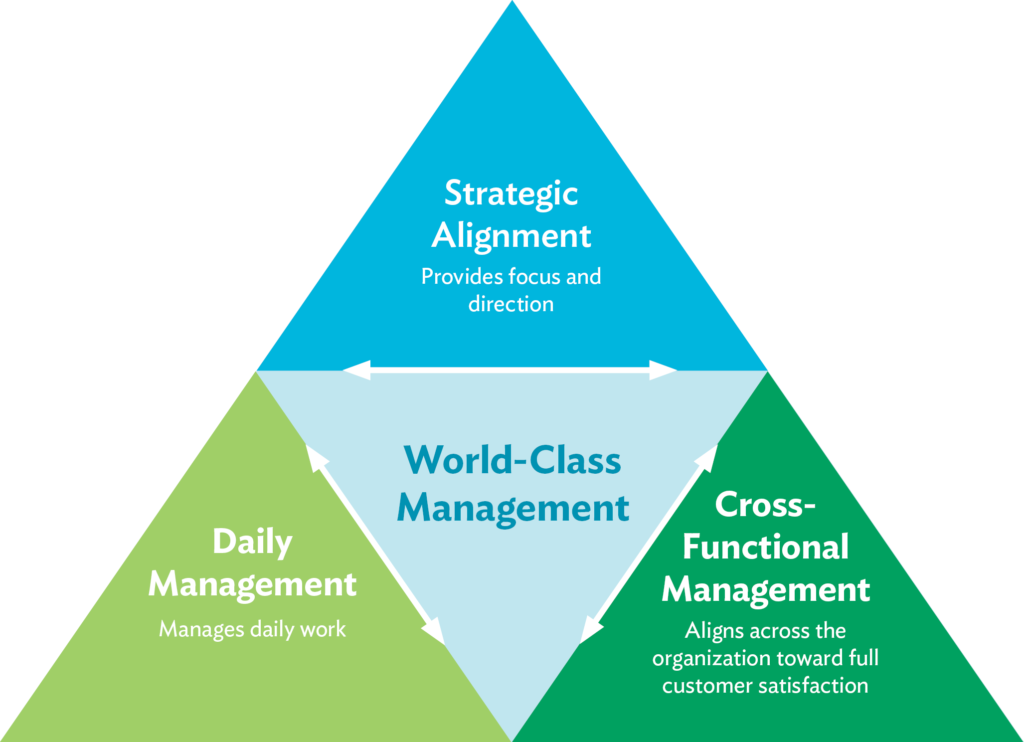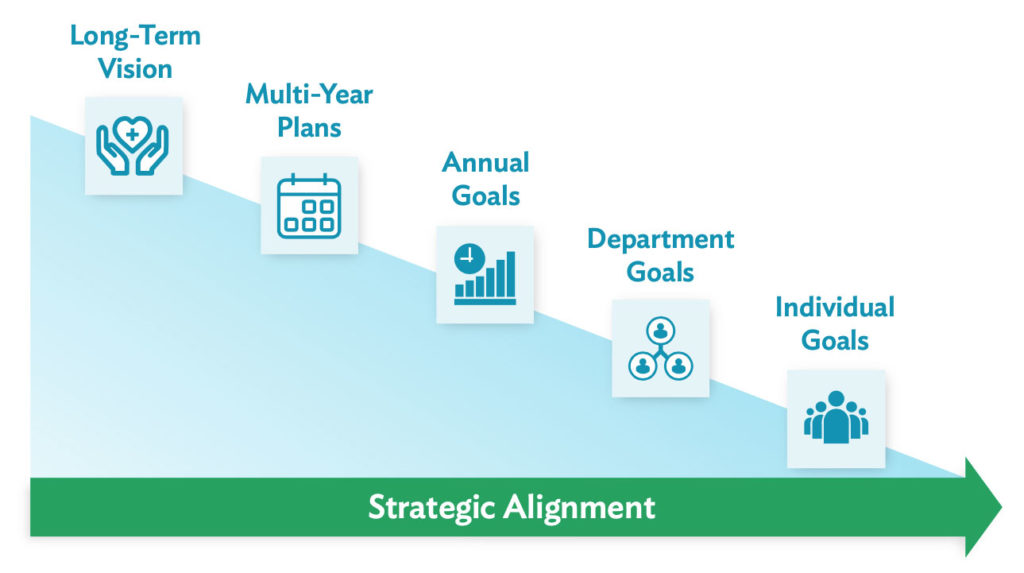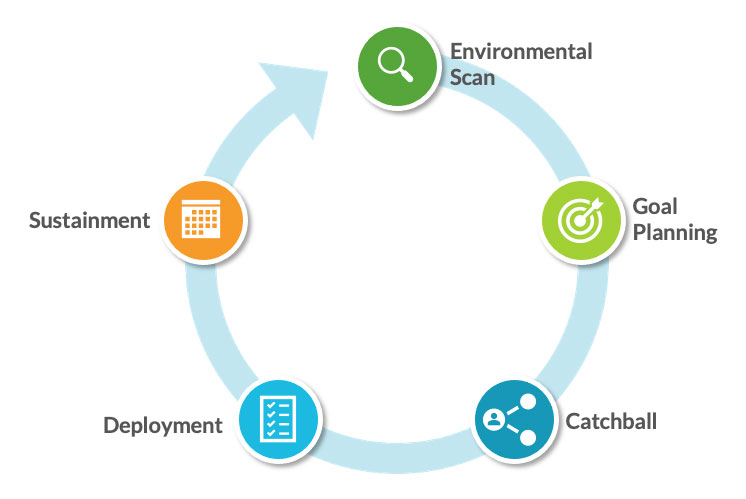Vision and Alignment in Healthcare: An Introduction to Strategic Goal Development and Deployment
What drives your teams to provide quality and value to each patient every day? How do you define those responsibilities and translate them to individual initiatives, departments and staff members? How does anyone know that you are making progress?
Simple as these questions are, many healthcare organizations don’t ask them. They set goals, but they don’t have a structure to help them follow through effectively. As a result, departments and teams function in silos, rather than a cooperative whole. Team members struggle to engage, because they aren’t motivated by or accountable to a clear and meaningful purpose. Improvement efforts take place within these functional silos and fail to spread or make a lasting difference.
These problems are even more acute during a crisis like the COVID-19 pandemic. The need to agree on priorities and cooperate on tactics increases dramatically. The more practice an organization has with strategic alignment, the more quickly and effectively they can respond.
Strategic alignment is the process of setting clear, meaningful goals and embedding them in the daily work and mindset of everyone in an organization. At Virginia Mason Institute, we’ve coached many healthcare organizations through this process, which we call Strategic Goal Development and Deployment (SGDD). We’ve seen firsthand how this helps them prevent waste and burnout and provide consistently safe and high-quality care. Our coaching and use of SGDD allows organizations to narrow their priorities from all of the work they could be doing to the most meaningful and essential work they must do to move their organizations forward.
In this post, we’ll break down the role that strategic alignment plays in an organization’s success. We’ll also look at the steps in our SGDD process that give organizations and their leaders the tools they need to drive and sustain progress.
A Core Component of Success
Strategic alignment begins at the top of the organization as the first of three components in a World-Class Management system. The other components are daily management, which integrates coaching and accountability into day-to-day work, and cross-functional management, which instills collaboration between departments.
Organizations are at their best when all three components are thriving. In a World-Class Management system, improvement and innovation are baked into the way people do their jobs every day, because people have self-sustaining skills that help them identify and fix issues permanently and in real time.

Strategic alignment sits at the top of the system because it builds from the organization’s vision — your True North. That vision should point the way for everyone in the organization, at every level.
To ensure that it does, the vision gets translated into increasingly local goals: from multi-year plans down to individual goals for staff development and performance.

But strategic alignment is about more than goals. It’s also about culture.
An organization’s cultural values and behaviors are like the current that carries goals, plans and messages forward. When values and behaviors are clear, communication and coordination are both enhanced. When those values and behaviors are undefined or inconsistent, communication breaks down, coordination is hampered, and plans fall short.
In particular, strategic alignment depends on a culture that consistently respects and values people. In that kind of culture, workers know their voices and actions fuel the organization’s success. They feel a greater sense of purpose and pride about their jobs, and actively engage in improving services and pursuing goals. You can learn about Virginia Mason’s journey to build this kind of culture, and the Respect for People framework we created along the way, in this brief overview.
Strategic Goal Development and Deployment: 5 Steps
SGDD is our process for helping leaders to begin building strategic alignment for their organizations. The goal is to build a process designed to be repeated annually, so that goals don’t fall out of step with current needs and opportunities.
SGDD consists of 5 steps and various tools for setting robust, achievable goals; nurturing buy-in at every level of the organization; and measuring success with key performance indicators that are communicated to all staff and evaluated by the board. Each year these steps are repeated, the organization learns and hones its journey to strategic alignment.

1. Environmental Scan
To start the process, organizations need to gain a deeper understanding of who they are and what the current state of their business is. This includes looking at the world outside of the organization as well as recent organization- or system-wide changes or collaborations and studying what got in the way or helped things along.
2. Goal Planning
The next stage is to identify and prioritize a few key goals for the year’s work. If everything is considered important, nothing will get finished. It’s important to narrow the focus and put all your effort into the highest priority goals until they are complete. It’s also critical to set target metrics at both the process and outcome level to measure where you stand currently against the progress you desire. Tracking progress and capturing key learnings helps you motivate staff and optimize tactics as you go.
3. Catchball
Catchball sessions are a way of engaging everyone in the organization in the process. This is important for demonstrating respect, since workers prefer to have their voices heard rather than being given mandates from above. But it’s also necessary to make the strategic plan as meaningful and effective as it can be: Good ideas can come from anywhere, after all. And the people who do the work every day know the realities of their jobs and patients better than anyone.
During catchball sessions, leaders share the results of the environmental scan along with drafts of next year’s goals. Then they ask for feedback on the focus and measurable impact for these goals. The tough questions and new ideas leaders encounter at this point help create the buy-in and alignment they’re looking for.
4. Deployment
Next, it’s time to integrate and align goals so that every staff member can contribute to them at their level. Managers communicate the organization’s strategic goals to their teams and explain the specific efforts and changes they will undertake to support those goals. Individuals follow a similar process, using tools to help them set VM SMART goals and track progress progressively, rather than only once a year.

Getting started with individual goal setting: Does your team have a standard way of developing individual goals that align with your department and organization goals? Use this worksheet to help ensure each team member has “VM SMART” goals.
5. Sustainment
The SGDD approach promotes long-term impact in two ways. First, it’s repeatable and evolves year over year based upon learnings captured after each year’s activity. Second, it uses elements of daily management and cross-functional management to weave strategic goals into the day-to-day work, conversations and attention of teams. These elements include:
- Regular opportunities for staff to participate in goal planning and have their feedback captured in the final outcome.
- Regular opportunities to reflect on gains and the progress still yet to be made.
- Daily opportunities to make improvements that contribute to common goals.
The SGDD model has helped many of our clients appreciate the importance of strategic alignment. Recent examples include University Hospitals at Coventry & Warwickshire NHS Trust, the Leeds Teaching Hospitals NHS Trust, and Surrey & Sussex Healthcare NHS Trust. As it relates to their response to the pandemic, one CEO remarked:
“Our partnership with VMI in the context of Covid has caused us to look at our strategic pyramid again. ‘Our vision and values, are they still valid?’ For example, we need to take seriously the well-being of our staff, and acknowledge their contributions every day.”
Related Video | Driving Strategic Priorities While Responding to the Global Pandemic
Watch Senior Transformation Sensei Chris Backous, MHA, explain how organizations can continue to drive strategic priorities even while responding to a crisis.
Related Service | Custom vision and alignment facilitation
Our experts are ready to help you with your needs around developing and deploying a strategic plan that fits your organization’s priorities.





